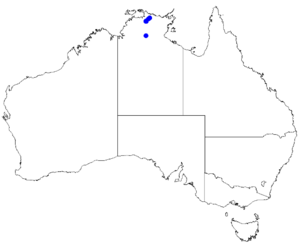Boronia rupicola facts for kids
Quick facts for kids Boronia rupicola |
|
|---|---|
| Scientific classification | |
 |
|
| Occurrence data from Australasian Virtual Herbarium |
Boronia rupicola is a special kind of plant that belongs to the citrus family, called Rutaceae. It only grows in a small part of the Northern Territory, Australia. This plant is a small bush with branches that hang down. It has simple or divided leaves and tiny, green flowers that are hard to notice.
Contents
What Does Boronia rupicola Look Like?
Boronia rupicola is a small bush with branches that droop downwards. It usually grows to be about 40 centimeters (16 inches) tall. This plant can even grow back from its roots if it gets damaged. Its branches are quite fragile and have a somewhat square shape when you look at them closely.
The leaves grow in pairs on opposite sides of the stem. Some leaves are simple, meaning they are just one piece. Others are pinnate, which means they are divided into smaller leaflets. The underside of the leaves is much lighter in color than the top.
The leaves are usually between 5 and 15 millimeters (0.2 to 0.6 inches) long and 1 to 4 millimeters (0.04 to 0.16 inches) wide. They grow on a small stem called a petiole, which is about 1.5 to 7 millimeters (0.06 to 0.28 inches) long. The tiny leaflets are shaped like an oval or a spearhead. They are about 7 to 10 millimeters (0.28 to 0.39 inches) long and 1 to 3 millimeters (0.04 to 0.12 inches) wide.
The flowers are a yellowish-green color and are quite small. They can grow alone or in small groups of up to three flowers. Each flower has tiny sepals, which are like small leaves at the base of the flower. These sepals are egg-shaped or triangular, about 1 to 1.5 millimeters (0.04 to 0.06 inches) long. The petals are about 2 to 2.5 millimeters (0.08 to 0.10 inches) long.
This plant blooms between March and July. After flowering, it produces a fruit called a capsule. This capsule is about 3.5 millimeters (0.14 inches) long and 2 millimeters (0.08 inches) wide.
How Boronia rupicola Got Its Name
The plant Boronia rupicola was officially described in 1997 by a scientist named Marco F. Duretto. He published his description in a science journal called Nuytsia.
The second part of its name, rupicola, comes from Latin words. "Rupestris" means "rocky," and "incola" means "inhabitant." So, the name rupicola means "rock dweller" or "rock inhabitant." This name makes sense because the plant loves to grow on rocky surfaces.
Where Does Boronia rupicola Live?
This special boronia plant only grows on vertical rock faces. It has only been found in two specific places in Australia's Northern Territory. One place is Mount Brockman, which is inside Kakadu National Park. The other area is south of Nabarlek in a region called Arnhem Land.
Is Boronia rupicola in Danger?
This plant is currently listed as "near threatened." This means it is not yet in immediate danger of disappearing, but it could become threatened in the future if its habitat is disturbed. Its status is protected under the Territory Parks and Wildlife Conservation Act 2000.

